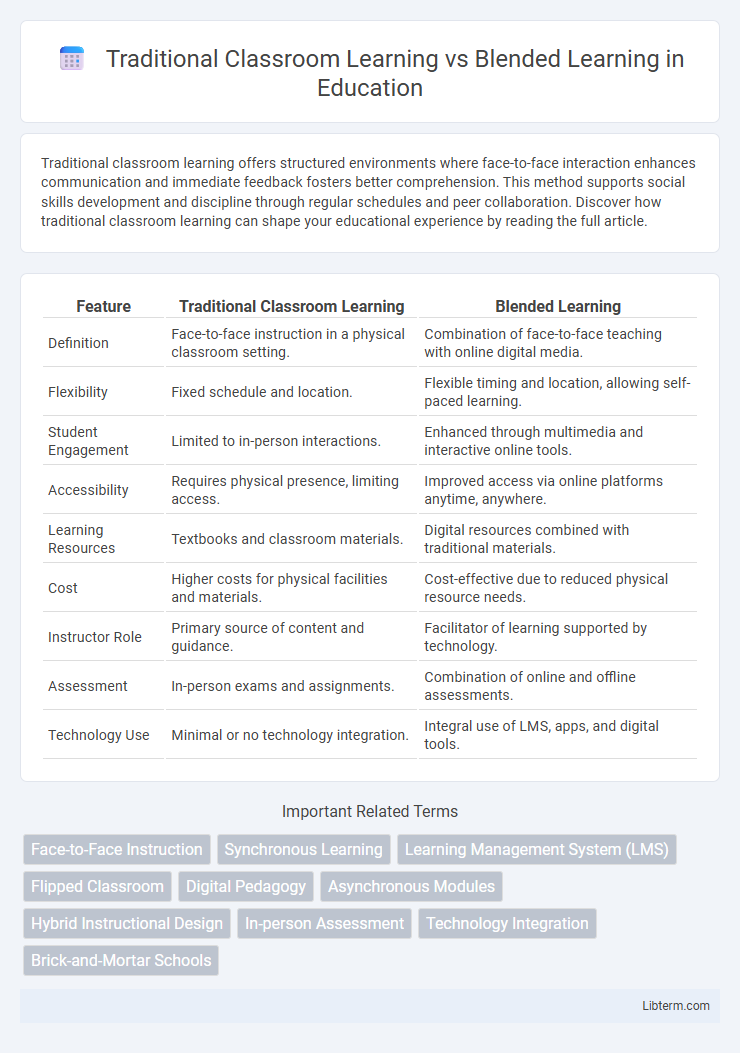Traditional classroom learning offers structured environments where face-to-face interaction enhances communication and immediate feedback fosters better comprehension. This method supports social skills development and discipline through regular schedules and peer collaboration. Discover how traditional classroom learning can shape your educational experience by reading the full article.
Table of Comparison
| Feature | Traditional Classroom Learning | Blended Learning |
|---|---|---|
| Definition | Face-to-face instruction in a physical classroom setting. | Combination of face-to-face teaching with online digital media. |
| Flexibility | Fixed schedule and location. | Flexible timing and location, allowing self-paced learning. |
| Student Engagement | Limited to in-person interactions. | Enhanced through multimedia and interactive online tools. |
| Accessibility | Requires physical presence, limiting access. | Improved access via online platforms anytime, anywhere. |
| Learning Resources | Textbooks and classroom materials. | Digital resources combined with traditional materials. |
| Cost | Higher costs for physical facilities and materials. | Cost-effective due to reduced physical resource needs. |
| Instructor Role | Primary source of content and guidance. | Facilitator of learning supported by technology. |
| Assessment | In-person exams and assignments. | Combination of online and offline assessments. |
| Technology Use | Minimal or no technology integration. | Integral use of LMS, apps, and digital tools. |
Introduction to Traditional and Blended Learning
Traditional classroom learning involves face-to-face instruction where students and teachers interact directly within a physical classroom setting. Blended learning combines online digital media with traditional classroom methods, allowing for more flexible and personalized educational experiences. This hybrid approach enhances engagement by integrating technology with conventional teaching practices.
Defining Traditional Classroom Learning
Traditional classroom learning involves face-to-face instruction where educators deliver content in a physical classroom setting, emphasizing direct interaction and real-time feedback. This method relies on structured schedules, standardized curriculum, and in-person assessments to facilitate knowledge acquisition. The environment fosters social engagement and collaborative learning through group activities and discussions.
Understanding Blended Learning Approaches
Blended learning combines traditional classroom instruction with digital and online media, allowing personalized pacing and interactive content that enhances student engagement and comprehension. This approach integrates face-to-face teaching with technology-driven methods such as virtual simulations, collaborative platforms, and multimedia resources to support diverse learning styles. Research shows blended learning improves knowledge retention and skill application compared to traditional classroom settings by offering flexible access to educational materials.
Key Differences Between the Two Methods
Traditional classroom learning involves face-to-face instruction within a physical classroom setting, emphasizing direct interaction between teachers and students. Blended learning combines in-person teaching with online educational resources, allowing for flexible pacing and personalized learning experiences. Key differences include the mode of content delivery, level of student autonomy, and the integration of technology to enhance engagement and accessibility.
Advantages of Traditional Classroom Learning
Traditional classroom learning offers direct, face-to-face interaction that fosters immediate feedback and personalized support from instructors, enhancing student comprehension. The structured environment promotes discipline and reduces distractions, encouraging consistent study habits and active participation. Physical presence also facilitates social skills development and collaboration through group activities and discussions, creating a cohesive learning community.
Benefits of Blended Learning Models
Blended learning models enhance student engagement by combining face-to-face instruction with digital resources, allowing personalized pacing and diverse learning styles. These models offer increased flexibility, enabling learners to access materials anytime and anywhere, which supports better retention and comprehension. Integrating technology in blended learning also fosters collaboration and critical thinking skills, preparing students for modern academic and professional environments.
Challenges in Traditional Learning Environments
Traditional classroom learning often faces challenges such as limited student engagement, fixed schedules, and lack of personalized instruction. These environments may struggle to accommodate diverse learning styles and slow feedback cycles, impacting overall academic performance. Infrastructure constraints and reliance on face-to-face interaction further hinder flexibility and access to varied educational resources.
Overcoming Hurdles in Blended Learning
Blended learning addresses common hurdles such as limited student engagement and technological barriers by integrating interactive digital tools with traditional face-to-face instruction. It enhances personalized learning experiences through adaptive platforms and real-time feedback, overcoming challenges of one-size-fits-all teaching seen in conventional classrooms. Effective training for educators in technology use and student access to reliable internet are critical factors in successfully implementing blended learning models.
Student Engagement and Learning Outcomes
Traditional classroom learning offers face-to-face interaction, fostering immediate feedback and structured routines that enhance student engagement through direct teacher supervision. Blended learning combines online digital media with traditional teaching methods, increasing flexibility and personalized learning paths, which can improve student motivation and accommodate diverse learning styles. Studies show that blended learning often yields higher learning outcomes by integrating interactive technology and allowing students to control their pace, leading to better retention and comprehension compared to conventional methods.
Choosing the Right Approach: Factors to Consider
Choosing the right approach between traditional classroom learning and blended learning involves evaluating factors such as student engagement, access to technology, and learning objectives. Traditional classroom settings provide face-to-face interaction and structured schedules, which are beneficial for students requiring direct supervision and social interaction. Blended learning combines online digital resources with in-person instruction, offering flexibility and personalized pacing, making it ideal for diverse learning styles and remote access needs.
Traditional Classroom Learning Infographic

 libterm.com
libterm.com